flak

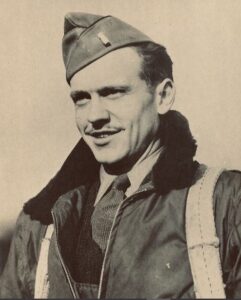 Because my dad, Allen Spencer was the flight engineer and top turret gunner on a B-17G in World War II, the B-17 has always held my interest. The plane was practically indestructible because of its great flying characteristics, resistance to combat damage, and fierce defensive firepower. Built by Boeing, it was called the B-17 Flying Fortress and it was the backbone of the American bomber force in Europe. In the European Theater of World War II (1939-1945), “one of the most dangerous occupations for Allied soldiers, sailors, or airmen was the flying of strategic bombers.” That was a statement that surprised me a little, because I would have expected the men on the ground to be in far more danger. I knew that there was a time my dad had to hang out of the open bomb bay doors to crank the landing gear down when they were damaged in combat, and I vaguely recall that they lost a ball turret gunner when he was wounded in battle and, while they pulled him out to render aid, they couldn’t save him.
Because my dad, Allen Spencer was the flight engineer and top turret gunner on a B-17G in World War II, the B-17 has always held my interest. The plane was practically indestructible because of its great flying characteristics, resistance to combat damage, and fierce defensive firepower. Built by Boeing, it was called the B-17 Flying Fortress and it was the backbone of the American bomber force in Europe. In the European Theater of World War II (1939-1945), “one of the most dangerous occupations for Allied soldiers, sailors, or airmen was the flying of strategic bombers.” That was a statement that surprised me a little, because I would have expected the men on the ground to be in far more danger. I knew that there was a time my dad had to hang out of the open bomb bay doors to crank the landing gear down when they were damaged in combat, and I vaguely recall that they lost a ball turret gunner when he was wounded in battle and, while they pulled him out to render aid, they couldn’t save him.
What I didn’t know about was something that happened on January 1, 1945, that was so bizarre that it seems like a ‘tall tale’ more than an actual event. Nevertheless, it was an actual event, and it was shocking. On that day, the Flying Fortress and the men who flew them were going to be tested beyond any limits they could have imagined, and beyond anything they were trained for. During a chaotic battle complete with ferocious anti-aircraft gunfire (flak) and enemy fighters, two B-17 Bombers managed to collide. A B-17, number 43-338457, piloted by 1st Lieutenant William G MacNab and 2nd Lieutenant Nelson B Vaughn, had risen upward. The top turret guns on MacNab’s plane had pierced through the aluminum skin on the bottom of 1st Lieutenant Glenn H Rojohn’s B-17, number 42-231987, binding the two huge planes together, as Rojohn’s co-pilot 2nd Lieutenant William G Leek, Jr said, like ‘breeding dragonflies.’ The two planes had become one. Upon impact, instead of exploding or breaking into pieces, the colliding planes became stuck together in a piggyback fashion, one atop the other. I’m sure that the men in the top plane, at least were in shock at this strange turn of affairs. I say the top plane, because it is thought that the men in the bottom plane were incapacitated or dead. There was no communication with them. Once the men realized that they weren’t going to crash, they would have to figure out their next move.
Even more shocked than the crew of the B-17 were the German fighter pilots who suddenly saw the whole confusing, but disastrous event. People just don’t expect that a mid-air collision could result in two planes stuck together. For the German fighter pilots, however, the situation took on an even more bizarre tone, because they honestly thought that the US must have created some sort of new secret weapon!! For the men onboard, the situation was dire. I’m sure they expected the explosion to come at any moment, so some of the airmen bailed out. The pilot of the top bomber, Rojohn tried, but was unable to separate the aircraft. Strangely, he was able to control the flight of the ‘hybrid dual-bomber’ somehow, despite turning his own engines off. The lower plane’s engines were still running, because its propellers were still turning. There was no communication with the crew of the bottom plane, which is why it was assumed that they were either incapacitated or already dead.
In a valiant effort, Rojohn decided to try to land the planes, probably hoping that the other crew could be saved, and complicated by the fact that he and his co-pilot, Leek couldn’t get out anyway. At that point, he might as well do his best to save the two or more of them that he could. He coaxed the joined bombers to a relatively safe landing in Germany at Wilhemshaven. Unfortunately, the lower bomber slid out from under the top bomber upon landing and immediately exploded. While the crew of the lower bomber perished in the landing and subsequent explosion, most of the crew of Rojohn’s B-17 survived and was taken prisoner. While being held in the camps, the German interrogators, who were skeptical of the account of the incident given by 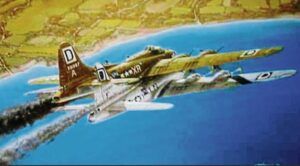
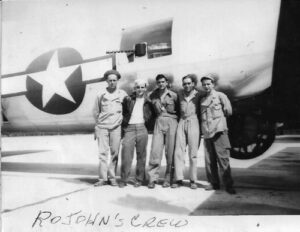 Rojohn, initially were of the opinion the flight represented a new American aerial design. I’m sure they later realized their error, but they must have also realized the resiliency of the B-17 Flying Fortress. Rojohn and his co-pilot, Leek, earned the Distinguished Flying Cross for their feat of aerial skill…a well-deserved award, if you ask me.
Rojohn, initially were of the opinion the flight represented a new American aerial design. I’m sure they later realized their error, but they must have also realized the resiliency of the B-17 Flying Fortress. Rojohn and his co-pilot, Leek, earned the Distinguished Flying Cross for their feat of aerial skill…a well-deserved award, if you ask me.

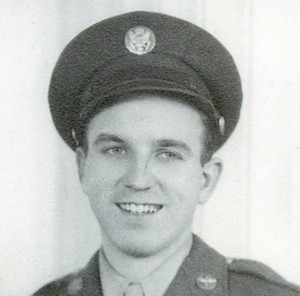 While listening to an audible book about World War II, called “Flak,” I heard one of the men being interviewed by the author for the book say, “History is told by the survivors.” It occurred to me that in most cases, at least in eras gone by, that was the truth. In order to know what really happened, there had to be a survivor. Even today, in an era of DNA, forensic science, black boxes, and phone video, there are events that cannot be definitively explained, and causes that remain a mystery.
While listening to an audible book about World War II, called “Flak,” I heard one of the men being interviewed by the author for the book say, “History is told by the survivors.” It occurred to me that in most cases, at least in eras gone by, that was the truth. In order to know what really happened, there had to be a survivor. Even today, in an era of DNA, forensic science, black boxes, and phone video, there are events that cannot be definitively explained, and causes that remain a mystery.
In World War II, survival was one of the main necessities to properly make an account of events. One might be able to look at pictures an know that the attack was bad, but in order to understand what it meant to fly through flak, someone had to really explain what the flak looked like up close, and tell us how hot it was when it got close enough to put a hole in the fuselage of the plane. We can imagine the fear the soldiers of World War II felt, but only because someone has “painted” a picture of just how bad it was to be pinned down in a foxhole with bombs raining down all around you, and bullets flying past if you tried to get out and run. No amount of 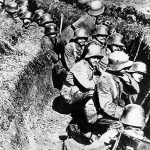 modern technology can explain how a soldier might have felt upon looking at his helmet to find a hole in it where shrapnel pierced it, and the soldier received only a small scratch. All of the “facts” that can be gleaned from the modern technology we have simply can’t tell us about how people felt.
modern technology can explain how a soldier might have felt upon looking at his helmet to find a hole in it where shrapnel pierced it, and the soldier received only a small scratch. All of the “facts” that can be gleaned from the modern technology we have simply can’t tell us about how people felt.
My dad, Allen Spencer was a top turret gunner in a B-17G bomber stationed in Great Ashfield. He told once about the ball turret gunner being shot up, and the desperate and futile effort to save his life. It was something Dad would never forget. The bombers that crashed taking all hands down with them, left no witnesses to tell if it was shot down or had engine trouble. If the plane could be found today, they might be able to guess at the cause of the crash, but it still might not be definitive. As to the soldiers who went missing in action, it was not uncommon for their body never to be found, and so no one could document their death, unless a buddy survived. All of the war stories we have today from World War II were told by the men, and women too, who survived. We know from the ones who witnessed the planes being shot down, blown up, or crashing with engine trouble. On the battlefield, the only witnesses were the other 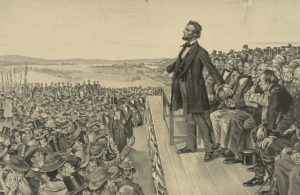 soldiers in the area, because the civilians had run far from the area.
soldiers in the area, because the civilians had run far from the area.
Even the non-war events of history had to have a “survivor” to tell about the event. It may not have been a violent event, but the Gettysburg Address would never have been known to anyone, if it had been spoken aloud in President Lincoln’s study with no one present. The speech might have been found later, but the depth of it’s meaning might have been completely lost had one witness not been so deeply moved by the speech. I wonder how much history was lost because no one was there to see and then survive to tell about it. It’s something to think about.
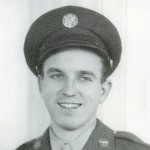
 As I have researched the infantry soldiers of World War II, my thought was that I was really thankful that my dad, Allen Spencer was not one of those men on the ground during the fighting. I felt bad for those men who were on the ground, fighting from the foxholes. I still do, because they were in constant danger. Bombs fall from the sky, and bullets fly from across the battlefield. If those things didn’t kill a soldier, the freezing cold, trench foot, or dysentery from the horribly unsanitary conditions could. It seemed that my dad’s situation was by far safer, but now, I’m not so sure that’s true.
As I have researched the infantry soldiers of World War II, my thought was that I was really thankful that my dad, Allen Spencer was not one of those men on the ground during the fighting. I felt bad for those men who were on the ground, fighting from the foxholes. I still do, because they were in constant danger. Bombs fall from the sky, and bullets fly from across the battlefield. If those things didn’t kill a soldier, the freezing cold, trench foot, or dysentery from the horribly unsanitary conditions could. It seemed that my dad’s situation was by far safer, but now, I’m not so sure that’s true.
The book I had been listening to, that took in World War II from D-Day to The Battle of the Bulge, talked mostly about the ground war, but then at the end, the reader said something that really struck me. It was about the look that crossed the face of a bomber crew’s faces before certain missions…those that would inevitably find the plane flying through flak. The look was one of fear. I knew flak was dangerous, but somehow I didn’t really connect flak with bringing down a plane, or seriously injuring its occupants. Nevertheless, it is quite dangerous for them.
As I researched the dangers of flak, a shocking revelation made itself known. I had written a story about the life expectancy of the ball turret gunner. My findings were that that life expectancy was about 12 seconds. That may be true when one is talking about the prospect of being shot, but when it comes to flak, that cannot be said. Apparently, where flak is concerned, the best place to be is in the plexiglass structure of the ball turret. Plexiglass holds up better against flak than other areas of the plane, so the ball turret gunner is much more protected…at least from flak. The same cannot be said for the bullets flying through the area. I was thankful that my dad was not a ball turret gunner, and that he only filled in as a waist gunner periodically. The waist gunners were in the open, where protection from bullets, and from flak was minimal…at best, non-existent at worst. I can’t imagine how those memories must have affected my dad, but in the book I listened to, the main reason many of the men didn’t want to talk about their experiences in World War II, or any war, was because talking about it brought those memories flooding in again.
After researching flak, and how it works, I can see why the men would get a look of fear on their faces as they prepared to go through areas anti-aircraft weapons shooting flak into the air. Some men said that they could see the red hot glow in the center of the flak, if it was very close. That tells me that it was like a small explosive devise. No wonder it could bring so much damage to a plane. I had known that flak could put holes in the fuselage, but somehow I hadn’t tied that with bringing down a plane. I surmise that it was the B-17 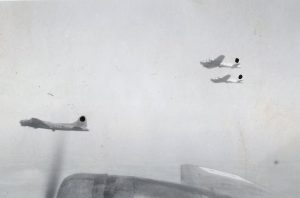
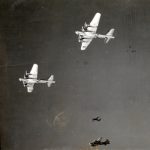 bomber top turret gunner’s daughter in me that wouldn’t allow me to place that danger around my dad. I didn’t want to think about the dangers of his every mission in World War II. My mind seems to have placed his plane in a bubble or a force field, so that no danger could come near him. I think every veteran wonders why they were spared, when others didn’t make it back home. I don’t think anyone can answer that question. As a Christian, I have to credit God for bringing my future dad home.
bomber top turret gunner’s daughter in me that wouldn’t allow me to place that danger around my dad. I didn’t want to think about the dangers of his every mission in World War II. My mind seems to have placed his plane in a bubble or a force field, so that no danger could come near him. I think every veteran wonders why they were spared, when others didn’t make it back home. I don’t think anyone can answer that question. As a Christian, I have to credit God for bringing my future dad home.

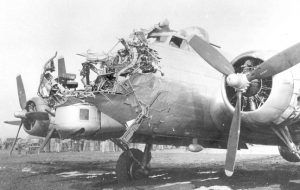 My dad was the top turret gunner and flight engineer on a B-17G Fortress Heavy Bomber during World War II. That was something that my family always knew. Dad didn’t talk much about it, but we were always very proud of him. What we didn’t know about all of that was that my dad was on the toughest plane ever built. At the time of his service, this little known fact probably wouldn’t have brought much comfort to his parents or siblings, but now, all these years later, it somehow brings a good measure of comfort to my dad’s daughter…me. My dad made it home from the war, of course. I know that there were times that his plane sustained damage, but it always brought the crew home.
My dad was the top turret gunner and flight engineer on a B-17G Fortress Heavy Bomber during World War II. That was something that my family always knew. Dad didn’t talk much about it, but we were always very proud of him. What we didn’t know about all of that was that my dad was on the toughest plane ever built. At the time of his service, this little known fact probably wouldn’t have brought much comfort to his parents or siblings, but now, all these years later, it somehow brings a good measure of comfort to my dad’s daughter…me. My dad made it home from the war, of course. I know that there were times that his plane sustained damage, but it always brought the crew home.
The testing of the B-17 Bomber, as is the case with most planes was rigorous. Is this great trial, the B-17 Flying Fortress put up one of most impressive displays, proving not only an effective carrier of firepower in which the plane delivered over a 3rd of the ordnance dropped by the allies in Europe and much of the ordnance dropped in the Pacific, but an astoundingly tough plane. Pilots and crews soon learned that the B-17s, which flew tens of thousands of missions under heavy anti-aircraft and fighter-plane pressure, could take extraordinary damage and still get home.
During the war years, the B-17s proved time and time again just what a wonderful plane they were. While they may not have brought their entire crew home every time they returned, they came home with part of them even with parts of the nose, propellers, and wings missing…and even with a tail that was hanging on by a thread. Of course, if the wing was torn completely off or the plane took a hit that ripped it in half, it did go down, but that is to be expected, as was the case with B-17G-15-BO “Wee Willie,” 322d BS, 91st BG, after direct flak hit on her 128th mission.
Still, the condition in which some of these planes came home would have shocked the builder altogether, if you ask me. I have looked at the pictures of these damaged planes, and I don’t know how they stayed in flight. The 
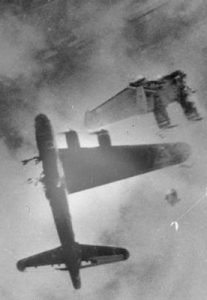 “All American,” with the 97th Bomber Group, made without a doubt, the most astonishing return. The plane had a huge gash in it’s tail section from a collision with an enemy fighter, whose wing sliced almost completely through the fuselage. The tail gunner was trapped at the rear of the plane because the floor connecting his section to the rest of the plane was gone. The plane was piloted by Lieutenant Kendrick Bragg, who flew 90 minutes back to base with the tail barely hanging on. One crew member said that the tail wagged like a dog’s tail. The pilot, proceeded to drop his bombs, and then made a U-turn taking the plane in a wide turn over 70 miles, so as not to stress the tail. When the plane landed and came to a complete stop, the tail finally broke off. Now that is one tough plane!!
“All American,” with the 97th Bomber Group, made without a doubt, the most astonishing return. The plane had a huge gash in it’s tail section from a collision with an enemy fighter, whose wing sliced almost completely through the fuselage. The tail gunner was trapped at the rear of the plane because the floor connecting his section to the rest of the plane was gone. The plane was piloted by Lieutenant Kendrick Bragg, who flew 90 minutes back to base with the tail barely hanging on. One crew member said that the tail wagged like a dog’s tail. The pilot, proceeded to drop his bombs, and then made a U-turn taking the plane in a wide turn over 70 miles, so as not to stress the tail. When the plane landed and came to a complete stop, the tail finally broke off. Now that is one tough plane!!
 As I continue to read through my dad’s letters to his family during World War II, I have been reading between the lines, and behind the scenes that he was able to share. During a war, the soldiers involved are unable to speak about the operations they are taking part in. Still as young men and women, far away from home, they want and need to write and receive letters. They need the closeness of family, and yet they don’t want to worry their family, and they are bound by military rules, not to talk about the missions. So much so, that letters must be read to make sure no information accidentally gets out.
As I continue to read through my dad’s letters to his family during World War II, I have been reading between the lines, and behind the scenes that he was able to share. During a war, the soldiers involved are unable to speak about the operations they are taking part in. Still as young men and women, far away from home, they want and need to write and receive letters. They need the closeness of family, and yet they don’t want to worry their family, and they are bound by military rules, not to talk about the missions. So much so, that letters must be read to make sure no information accidentally gets out.
Knowing my dad in his later years, and getting to know him through his letters home, I know that he was not a man who wanted others, especially his family to worry about him. So, he never told of pain or fears. Which leads me to believe that my dad wouldn’t have told his family, and especially his mom, what he was feeling during the bombing missions he went on every day. Not even if he could have. That was just the man my dad was…as a young soldier, and as a adult husband and father.
Still, in reading his letters, the need for comfort and reassurance that existed in him every day, whispered quietly from between the lines and behind the words my dad wrote in his letters. He asked for good news concerning men he knew that were in the service too. Hoping that if they were ok, he would be too. Of course, I can’t be sure that those were my dad’s feelings or his thoughts, but I know that is how I felt when I looked at the pictures he took of flak from the German Fliegerabwehrkanone. This was an 88mm gun capable of rapid fire. The resulting shell fragments would rip through the planes and it is said that it took over 3,300 rounds to take down a plane. And those guns did take down planes. The B-17 bombers had to fly through these traps on the way to and from their targets. How could these boys go through that every day and not have fear that they would not come home. I know it took great faith in God to move beyond that fear…to keep going…to survive the  day to day nerve racking missions.
day to day nerve racking missions.
I have great respect for all of our soldiers, because they push their fears back every day, and hide their true feelings from their loved ones so they don’t worry. And yet, when I look at the pictures Dad took of the flak all around their plane, and read the letters telling his family that he is “ok and feeling fine”, which is really a way of saying he is still ok, and not telling them much of anything I think I understand what true bravery is. That was typically my dad, never allowing his feelings to worry his family. I feel that I know my dad better from his letters and it makes me appreciate what a wonderful man he was even more. I love you Daddy!!

